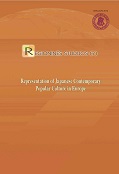Kawaii as Represented by Wearers in France Using the Example of Lolita Fashion
Kawaii as Represented by Wearers in France Using the Example of Lolita Fashion
Author(s): Kyoko KomaSubject(s): Cultural Essay, Political Essay, Societal Essay
Published by: Vytauto Didžiojo Universitetas
Keywords: Kawaii; Lolita wearers in France; identity; exoticism; orientalism; immaturity; acculturation; transnational; Kawaii; Lolitos stiliaus dėvėtojai Prancūzijoje; identitetas; egzotizmas; orientalizmas; nesubrendimas; akultūracija; transnacionalinis
Summary/Abstract: Since the 1990s when Japanese popular culture, such as manga, extravagant street fashion, video games, etc. were exported to the world, the term ‘kawaii’ has also appeared in Europe, in particular in France, one of the countries that has absorbed Japanese popular culture the most. I have examined how the term kawaii, one of the key words of Japanese popular culture as disseminated in foreign countries, adds a new semiotic value to images of Japan in France from several points of view. These points of view come from ‘onlookers’ as well as wearers: for example, I have used analysis of media (newspapers, fashion magazines, Internet magazines, books, etc.), and interviews with French, Lithuanian, South Korean and Taiwanese students interested in Japanese language and culture (Koma 2011, 2012), in order to make clear if the term kawaii will be accepted in France with the same meaning as it has in Japan, and to understand how European countries acculturate kawaii in each social context. Through my previous research, I conclude that the acculturation of kawaii could be considered exoticismorientalism for the French, who have a heritage of Japonism-Orientalism-exoticism from the end of the 19th century. Kawaii in Europe does not correspond to kawaii in Japan; kawaii is a persistent stereotype (that of immaturity) relating to Japan. To examine my hypothesis further, in this paper, I will examine how kawaii is represented by Lolita Fashion wearers (considered one of the kawaii fashions) through interviews with them in France. Through analysis of various levels of discourse (the media, wearers of kawaii fashion, kawaii fashion admirers), I intend to make the representation of kawaii in France clear from the point of view of communication studies. Nuo 9 dešimtmečio japonų populiarioji kultūra – komiksai (manga), ekstravagantiška gatvės mada, video žaidimai ir t. t. – buvo pradėta aktyviai eksportuoti į visą pasaulį. Tuo pat metu Europoje atsirado terminas kawaii, kuris ypač įsitvirtino Prancūzijoje – vienoje iš šalių, kuriai itin didelę įtaką padarė japonų populiarioji kultūra. Straipsnyje nagrinėjama, kaip kawaii – viena iš pagrindinių japonų populiariosios kultūros sąvokų užsienio valstybėse – kuria naują Japonijos įvaizdžio Prancūzijoje semiotinę reikšmę iš kelių skirtingų nuomonių. Tai ir stebėtojų, ir pačioje kultūroje dalyvaujančiųjų nuomonės. Pavyzdžiui, aš analizavau žiniasklaidą (laikraščius, mados žurnalus, internetinius žurnalus, knygas, t. t.) ir interviu, darytus su Prancūzijos, Lietuvos, Pietų Korėjos ir Taivano studentais, kurie domisi japonų kalba ir kultūra (Koma 2011, 2012), tam, kad išsiaiškinčiau, ar kawaii terminas Prancūzijoje turės tokią pačią prasmę, kaip ir Japonijoje. Straipsnyje taip pat siekiama atsakyti, kaip Europos valstybės sukultūrina kawaii savo socialiniame kontekste.
Journal: Regioninės studijos
- Issue Year: 2013
- Issue No: 7
- Page Range: 67-82
- Page Count: 16
- Language: English

